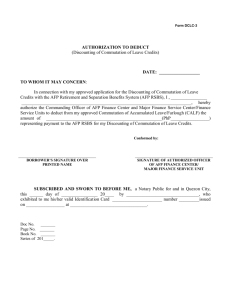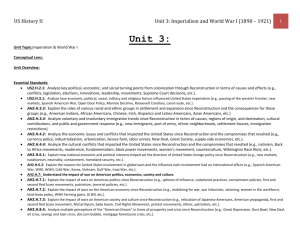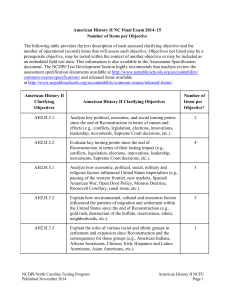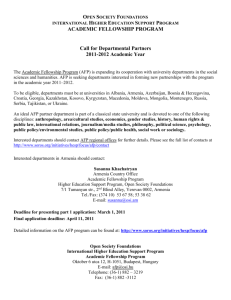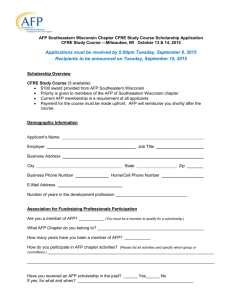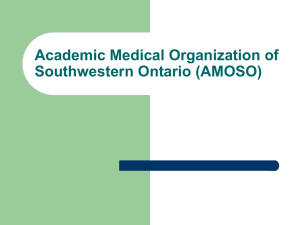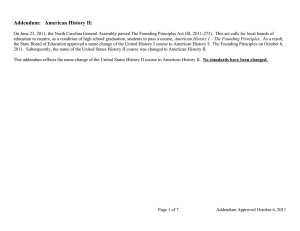World War II and the Cold War
advertisement
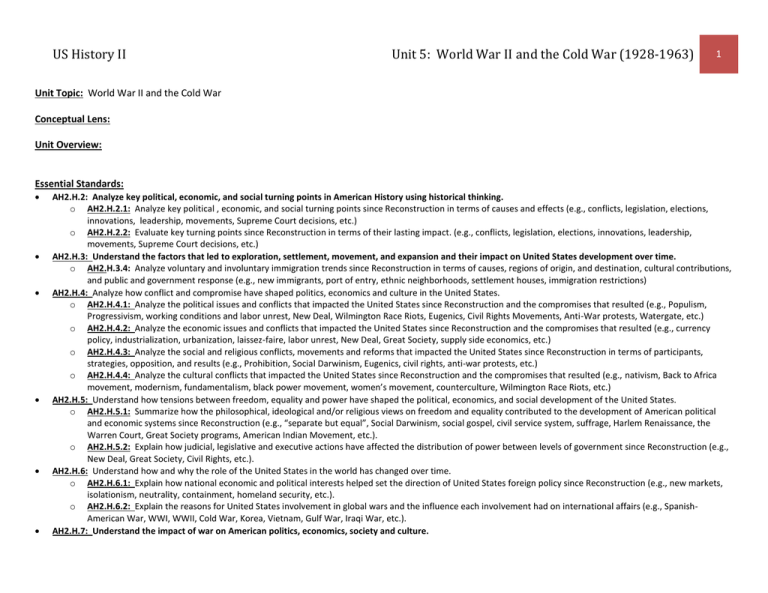
US History II Unit 5: World War II and the Cold War (1928-1963) 1 Unit Topic: World War II and the Cold War Conceptual Lens: Unit Overview: Essential Standards: AH2.H.2: Analyze key political, economic, and social turning points in American History using historical thinking. o AH2.H.2.1: Analyze key political , economic, and social turning points since Reconstruction in terms of causes and effects (e.g., conflicts, legislation, elections, innovations, leadership, movements, Supreme Court decisions, etc.) o AH2.H.2.2: Evaluate key turning points since Reconstruction in terms of their lasting impact. (e.g., conflicts, legislation, elections, innovations, leadership, movements, Supreme Court decisions, etc.) AH2.H.3: Understand the factors that led to exploration, settlement, movement, and expansion and their impact on United States development over time. o AH2.H.3.4: Analyze voluntary and involuntary immigration trends since Reconstruction in terms of causes, regions of origin, and destination, cultural contributions, and public and government response (e.g., new immigrants, port of entry, ethnic neighborhoods, settlement houses, immigration restrictions) AH2.H.4: Analyze how conflict and compromise have shaped politics, economics and culture in the United States. o AH2.H.4.1: Analyze the political issues and conflicts that impacted the United States since Reconstruction and the compromises that resulted (e.g., Populism, Progressivism, working conditions and labor unrest, New Deal, Wilmington Race Riots, Eugenics, Civil Rights Movements, Anti-War protests, Watergate, etc.) o AH2.H.4.2: Analyze the economic issues and conflicts that impacted the United States since Reconstruction and the compromises that resulted (e.g., currency policy, industrialization, urbanization, laissez-faire, labor unrest, New Deal, Great Society, supply side economics, etc.) o AH2.H.4.3: Analyze the social and religious conflicts, movements and reforms that impacted the United States since Reconstruction in terms of participants, strategies, opposition, and results (e.g., Prohibition, Social Darwinism, Eugenics, civil rights, anti-war protests, etc.) o AH2.H.4.4: Analyze the cultural conflicts that impacted the United States since Reconstruction and the compromises that resulted (e.g., nativism, Back to Africa movement, modernism, fundamentalism, black power movement, women’s movement, counterculture, Wilmington Race Riots, etc.) AH2.H.5: Understand how tensions between freedom, equality and power have shaped the political, economics, and social development of the United States. o AH2.H.5.1: Summarize how the philosophical, ideological and/or religious views on freedom and equality contributed to the development of American political and economic systems since Reconstruction (e.g., “separate but equal”, Social Darwinism, social gospel, civil service system, suffrage, Harlem Renaissance, the Warren Court, Great Society programs, American Indian Movement, etc.). o AH2.H.5.2: Explain how judicial, legislative and executive actions have affected the distribution of power between levels of government since Reconstruction (e.g., New Deal, Great Society, Civil Rights, etc.). AH2.H.6: Understand how and why the role of the United States in the world has changed over time. o AH2.H.6.1: Explain how national economic and political interests helped set the direction of United States foreign policy since Reconstruction (e.g., new markets, isolationism, neutrality, containment, homeland security, etc.). o AH2.H.6.2: Explain the reasons for United States involvement in global wars and the influence each involvement had on international affairs (e.g., SpanishAmerican War, WWI, WWII, Cold War, Korea, Vietnam, Gulf War, Iraqi War, etc.). AH2.H.7: Understand the impact of war on American politics, economics, society and culture. US History II o o o Unit 5: World War II and the Cold War (1928-1963) 2 AH2.H.7.1: Explain the impact of wars on American politics since Reconstruction (e.g., spheres of influence, isolationist practices, containment policies, first and second Red Scare movements, patriotism, terrorist policies, etc.). AH2.H.7.2: Explain the impact of wars on the American economy since Reconstruction (e.g., mobilizing for war, war industries, rationing, women in the workforce, lend-lease policy, WWII farming gains, GI Bill, etc.) AH2.H.7.3: Explain the impact of wars on American society and culture since Reconstruction (e.g., relocation of Japanese Americans, American propaganda, first and second Red Scare movement, McCarthyism, baby boom, Civil Rights Movement, protest movements, ethnic, patriotism, etc.). Conceptual Webbing: Exploration, Settlement, Movement, and Expansion Conflict and Compromise Freedom, Equality, International and Power Affairs and Foreign Policy Thematic Abstracts: Thematic Abstracts: War Progress, Crises, and the American Dream Thematic Abstracts: Thematic Abstracts: Thematic Abstracts: Essential Vocab Essential Vocab Essential Vocab Essential Questions: Essential Vocab Isolationism; Neutrality Acts; Cash and Carry; Destroyers for Bases; Lend-Lease Plan; Appeasement; Munich Pact; Quarantine Speech; Atlantic Charter; Conference in Casablanca; Conference in Tehran; Conference in Yalta; Potsdam; Essential Vocab Battle of Midway; Attack on Pearl Harbor; Battle of Stalingrad; D-Day invasion; Hiroshima; Nagasaki; Manhattan Project; Essential Vocab US History II Unit 5: World War II and the Cold War (1928-1963) Exploration, Settlement, Movement, and Expansion EQs: Conflict and Compromise EQs 1. McDougal-Littell Resources a. Textbook: The Americans b. Internet: www.Classzone.com 2. Other Internet Resources 3. Literature 4. Audio/Visual Resources Freedom, Equality, International and Power Affairs and Foreign Policy EQs EQs War EQs 3 Progress, Crises, and the American Dream EQs

